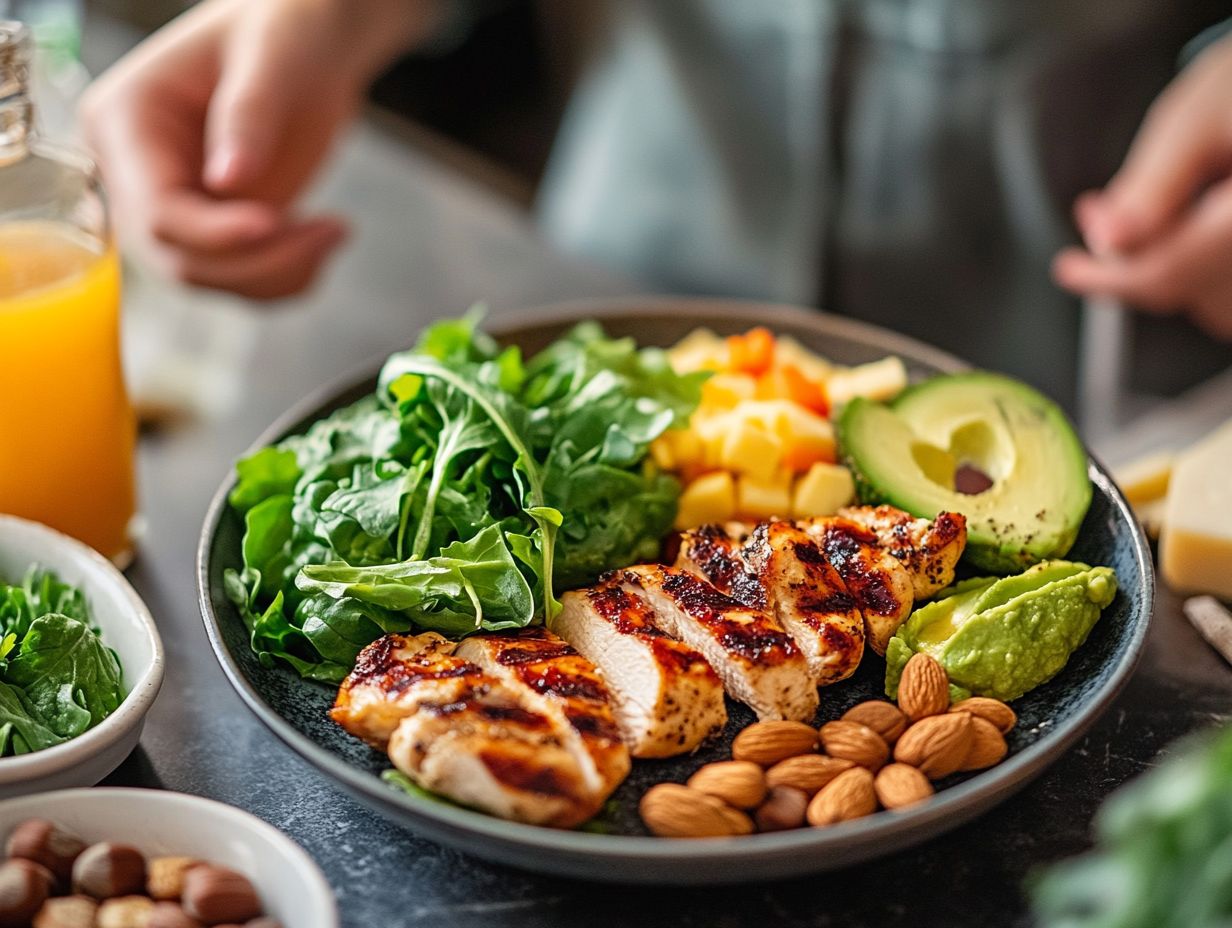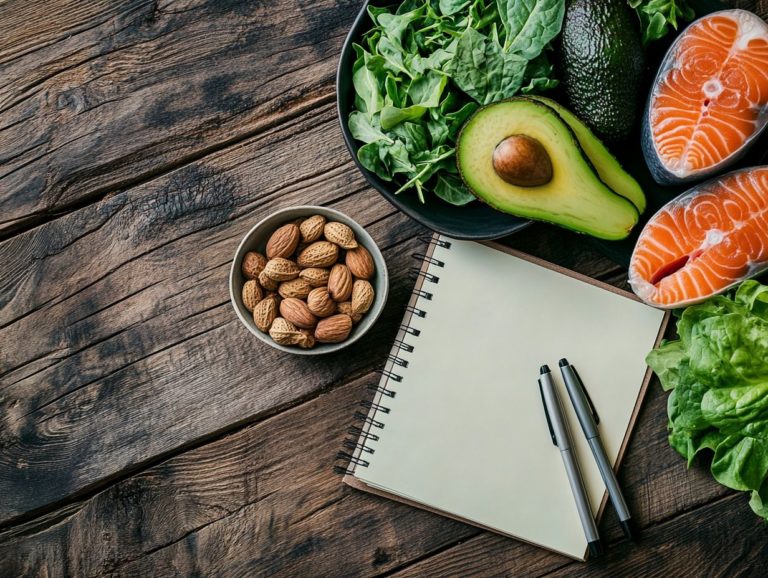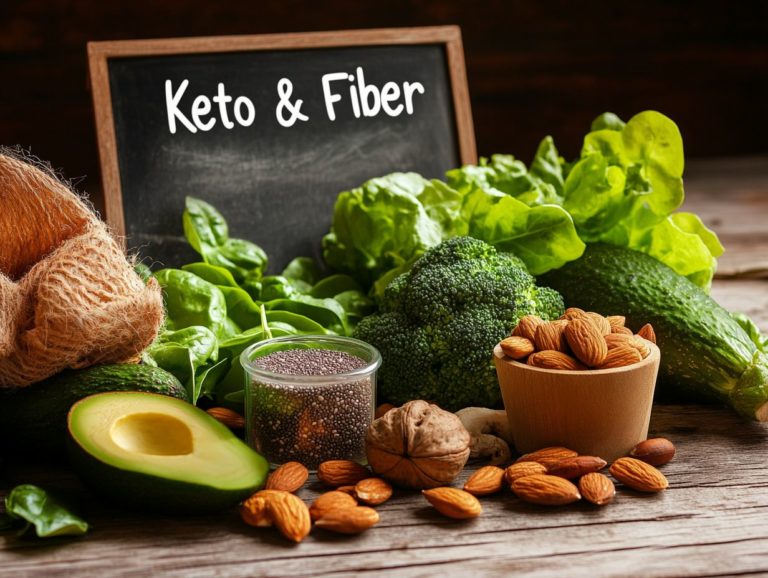How to Maintain Keto Lifestyle: Common Questions
Embracing a keto lifestyle can unlock a wealth of benefits for you, ranging from effective weight loss to increased energy levels and better blood sugar control. You’re about to embark on an exciting journey into the keto lifestyle!
If you’re eager to embark on this low-carb journey, wondering about the best foods to include or avoid, the impact of keto flu, and how to sustain your progress, you’re in the perfect spot.
This guide will clarify common misconceptions and provide you with delectable snack options to keep you aligned with your goals.
Are you ready to explore the intricacies of the keto lifestyle, including managing keto breath? Let’s dive in!
Contents
- Key Takeaways:
- What Are the Benefits of a Keto Lifestyle?
- What Foods Can You Eat on a Keto Diet?
- What Foods Should You Avoid on a Keto Diet?
- How Do You Maintain a Keto Lifestyle?
- What Are Common Misconceptions About the Keto Lifestyle?
- What Are Some Keto-friendly Snack Options?
- 3. Hard-boiled Eggs
- 4. Cheese and Meat Roll-ups
- Frequently Asked Questions
- How can I transition into a keto lifestyle?
Key Takeaways:
- Keto lifestyle offers benefits such as weight loss, improved blood sugar control, increased energy levels, and reduced inflammation. It’s also beneficial for diabetes management and epilepsy.
- To start a keto lifestyle, calculate your macros, stock up on keto-friendly foods, plan meals, and stay hydrated.
- Stick to healthy fats, low-carb vegetables, and high-quality protein while avoiding high-carb foods, processed foods, and sugary drinks on a keto diet. Be mindful of nutrient deficiencies that can arise from excluding certain food groups like fruits and whole grains.
What Are the Benefits of a Keto Lifestyle?
Embracing a keto lifestyle opens the door to a plethora of benefits that extend far beyond mere weight loss, making it an appealing option for anyone seeking to enhance their overall health and well-being. The keto diet, defined by its low carbohydrate intake and high levels of dietary fat, triggers a metabolic state known as ketosis, which is the state where the body burns fat for fuel instead of carbs. This is particularly beneficial for individuals following a keto vegetarian approach.
In this state, your body becomes adept at burning fat for energy rather than relying on carbohydrates. This dietary approach proves especially advantageous for those managing diabetes and insulin resistance. It can assist in stabilizing blood sugar levels and lowering the risk of high cholesterol. It is essential to consult a health care provider before making significant dietary changes, especially if you have pre-existing health conditions.
1. Weight Loss
One of the most compelling reasons you might consider adopting a keto diet is its remarkable effectiveness for weight loss. This occurs as your body shifts into ketosis, a state in which it burns fat for fuel instead of carbohydrates.
Achieving this metabolic transition primarily involves significantly reducing your carbohydrate intake. This subsequently lowers your insulin levels—the hormone that plays a crucial role in fat storage. When you minimize your carb consumption, your insulin levels decline, promoting lipolysis (the process of breaking down fat for energy). Be cautious of elevated cholesterol levels, including both saturated fat and high cholesterol, when increasing fat intake.
To maintain this ketogenic state, it’s essential to balance your meals by incorporating adequate amounts of healthy fats and proteins. A higher intake of fats can sometimes result in elevated cholesterol levels, so monitoring your health is necessary to ensure your cardiovascular well-being is preserved.
2. Improved Blood Sugar Control
The keto diet is well-known for its ability to enhance blood sugar control. This makes it a great choice for those with diabetes or insulin resistance.
By cutting back on carbohydrates, this diet reduces glucose spikes in your bloodstream. You’ll maintain steady energy levels while needing less insulin production.
You might notice an improvement in your insulin sensitivity. This is essential for managing your blood sugar effectively.
However, starting a keto diet often brings about changes in your electrolyte balance. So, be mindful of your intake of sodium, potassium, and magnesium.
Attention to electrolyte management is essential. Imbalances can lead to discomforts such as fatigue and muscle cramps. Be cautious about the potential effects of alcohol on keto, as it can disrupt ketosis.
Though the diet frequently faces criticism for potentially raising cholesterol levels, emerging research suggests that many individuals actually see enhancements in their lipid profiles. This includes increased levels of HDL (the “good” cholesterol) and healthier triglyceride levels. Monitoring ketone bodies can provide insights into your maintenance of ketosis.
3. Increased Energy Levels
Embracing a keto lifestyle can elevate your energy levels. Your body becomes adept at using fat as its primary fuel source through ketosis.
This metabolic shift not only curtails the frequent highs and lows of carbohydrate consumption but also fosters a steady stream of energy throughout your day.
When you move away from heavy carbs, your body taps into its fat reserves, which release energy consistently. This transformation boosts your mental clarity and elevates your physical endurance! It is especially beneficial for managing ADHD symptoms or enhancing athletic performance.
Dietary fat is pivotal in this journey. It provides essential fatty acids while supporting overall cellular function. This is particularly important for individuals on a low-carb diet.
By prioritizing healthy fat sources, you can sustain your energy levels and promote your overall well-being.
4. Reduced Inflammation
A keto diet can significantly reduce inflammation in your body. This is beneficial for your overall health and helps manage conditions like insulin resistance.
By incorporating healthy fats such as avocados, olive oil, and fatty fish into your meals, you harness the powerful anti-inflammatory properties of these foods. These fats stabilize cellular membranes. This action reduces the activation of inflammatory pathways.
It is also helpful for conditions like PCOS and pregnancy, where inflammation plays a critical role.
When you lower your carbohydrate intake, you can significantly influence your body’s insulin response. This leads to decreased inflammation markers in your bloodstream.
However, it’s crucial to approach the keto diet thoughtfully. An unbalanced version can result in nutrient deficiencies, especially in vitamins and minerals found in fruits, vegetables, and whole grains.
By ensuring a well-rounded intake, you promote reduced inflammation while maintaining overall nutritional adequacy. This makes the keto lifestyle more sustainable and beneficial for the long haul. Incorporating a variety of low-carb foods can help mitigate these deficiencies.
How Do You Start a Keto Lifestyle?
Starting a keto lifestyle entails a series of essential steps.
- Begin by calculating your macros to understand your ideal carbohydrate, protein, and fat intake.
- Next, stock your pantry with keto-friendly foods that align with your new dietary goals, ensuring they are also keto-safe.
- Thoughtful meal planning becomes crucial as you navigate this lifestyle. This ensures you have satisfying options at your fingertips.
- Don’t overlook the importance of proper hydration. It plays a vital role in maintaining ketosis effectively.
1. Calculate Your Macros
Calculating your macros is a critical step when embarking on a keto diet. It allows you to grasp the optimal balance of carbohydrates, proteins, and dietary fats required to enter ketosis.
On a typical ketogenic diet, you’ll want to aim for a breakdown of approximately 5-10% of your daily calories from carbohydrates, 20-25% from protein, and around 70-75% from healthy fats. This specific ratio encourages your body to shift into a metabolic state where it burns fat for energy instead of glucose. Monitoring your ketone levels helps you understand how well you adhere to these macro ratios.
These ratios can, of course, be fine-tuned based on your unique health goals, whether that’s weight loss or muscle gain. Consider your activity level and insulin sensitivity. If you deal with insulin resistance, a lower carb intake could be advantageous. Athletes might benefit from increasing their protein intake to aid muscle repair and growth. You must consult your healthcare provider to tailor these ratios to your specific needs.
Pay close attention to how your body responds and adjust your macro distribution as needed to maximize your results.
2. Stock Up on Keto-friendly Foods
To successfully transition to a keto lifestyle, you must stock up on keto-friendly foods that are low in carbohydrates and rich in healthy fats.
This means embracing a variety of low-carb vegetables, such as spinach and zucchini. These are packed with nutrients and fiber while steering clear of starchy options. Healthy fats are pivotal in this diet; think olive oil and butter. They enhance flavor and help you feel full and satisfied. Avoid high-carb foods like sugary drinks and bread.
Prioritize high-quality protein sources, like grass-fed meats and free-range eggs. This ensures you meet your nutritional needs without exceeding your carb limits. Avoid foods brimming with carbohydrates, as they can impede your body’s ability to enter ketosis. Don’t overlook the effects of alcohol on keto; many beverages hide sugars that can easily derail your progress.
3. Plan Your Meals
Meal planning is essential for maintaining your keto diet. It helps you stay within your carb limits while meeting your protein and dietary fat goals.
By organizing your meals ahead of time, you can effortlessly track your macronutrient intake and avoid common traps like impulse eating or unhealthy snacks. A successful keto lifestyle revolves around healthy fats, moderate protein, and very low carbs. Incorporating a variety of keto-friendly foods, such as avocados, nuts, and leafy greens, into your weekly menus is beneficial. Consider the potential for nutrient deficiencies and incorporate keto-safe supplements if necessary.
To create balanced meals, prep ingredients in bulk. Grilling several chicken breasts or roasting a large batch of vegetables provides quick and easy options throughout the week. This method aligns well with a low-carb diet and helps manage your carb intake efficiently.
Keep a well-stocked pantry filled with keto staples and plan meals that combine these essential components. This will pave the way for your lasting success on this dietary journey. Always include keto foods rich in healthy fats and low in carbohydrates to maintain your ketone levels.
Start planning your meals today to see results faster!
4. Stay Hydrated
Staying hydrated is absolutely crucial during the early stages of your keto journey, as it helps alleviate the symptoms of keto flu and maintain a proper balance of electrolytes. It also prevents keto breath.
As your body transitions into ketosis—a metabolic state where your body burns fat for energy instead of carbohydrates—it undergoes various adjustments that can sometimes lead to dehydration and an imbalance of essential minerals like sodium, potassium, and magnesium. This is especially important to consider since the ketosis process tends to increase the loss of water and electrolytes through urine.
If you experience fatigue, headaches, or muscle cramps, don’t worry! Staying hydrated can help. These symptoms can often be mitigated by ensuring you stay properly hydrated and replenish those vital electrolytes.
Make it a point to drink water regularly and fuel your body with nourishing foods! To keep yourself adequately hydrated, prioritize drinking plenty of water throughout the day. You can also incorporate broth, electrolyte supplements, and low-carb vegetables that are rich in these minerals to support a smoother transition and elevate your overall well-being during this dietary shift.
What Foods Can You Eat on a Keto Diet?
On a keto diet, you have the opportunity to enjoy a variety of foods that are abundant in healthy fats, low in carbohydrates, and offer high-quality protein, all designed to meet your nutritional needs.
1. Healthy Fats
Healthy fats are the cornerstone of your keto diet, supplying the necessary energy while helping you maintain ketosis and overall health. These fats contribute not only to satisfying meals but also play a crucial role in various bodily functions.
For instance, high-quality sources like olive oil are rich in monounsaturated fats that support heart health, while butter from grass-fed cows delivers beneficial fat-soluble vitamins. Avocados are a treasure trove of fiber and potassium, aiding digestion and promoting a sense of fullness. Nuts, such as almonds and walnuts, offer essential nutrients like omega-3 fatty acids, which can help reduce inflammation and boost brain function.
By incorporating these healthy fats into your diet, you can optimize your energy levels and enjoy a myriad of health benefits.
2. Low-carb Vegetables
Incorporating low-carb vegetables into your meals is essential on a keto diet, as they provide vital nutrients without compromising your carbohydrate intake.
Think of these vegetables as your culinary allies: leafy greens like spinach and kale, cruciferous options such as broccoli and cauliflower, and vibrant selections like zucchini and bell peppers. Each of these is packed with fiber, vitamins, and minerals, enriching your diet while keeping carbs in check.
These veggies play a critical role in preventing nutrient deficiencies that can stem from strict dietary restrictions. For example, spinach is rich in iron, while broccoli serves up a healthy dose of vitamin C and essential antioxidants.
By including these keto-approved vegetables in your diet, you can maintain overall health, support digestion, and ensure your body receives the necessary nutrients—all while happily staying within your carb limits.
3. High-quality Protein
High-quality protein sources are essential to your keto diet, supporting muscle maintenance and encouraging weight loss while keeping you feeling satisfied. By incorporating a diverse range of proteins—such as lean animal proteins, eggs, and even plant-based alternatives if you’re leaning towards a keto vegetarian lifestyle—you enhance the nutritional profile of your meals significantly.
These protein sources not only increase feelings of fullness but also play a vital role in muscle repair and growth. This is especially advantageous during weight loss and managing insulin resistance.
Ensuring you consume adequate protein helps balance healthy fats, allowing you to maintain the essential nutrients necessary for thriving on this low-carbohydrate journey. Achieving this balance is crucial for sustainable energy levels, improved metabolic health, and your overall well-being.
Monitoring your protein intake and dietary fat proportions can further assist in maintaining this balance.
What Foods Should You Avoid on a Keto Diet?
To follow a keto diet successfully, you must steer clear of high-carb foods, processed items, and sugary beverages. These can easily disrupt your progress and the state of ketosis you aim to achieve.
1. High-carb Foods
When starting a keto diet, avoid high-carb foods like grains, bread, pasta, and sugary snacks. This helps maintain a low carb intake and achieve ketosis effectively.
These foods can affect your blood sugar levels, causing spikes that lead to unwanted energy crashes. Such fluctuations trigger your pancreas to produce more insulin, a hormone that regulates blood sugar but also encourages fat storage.
As you consume high-carb options, cravings may intensify, making it difficult to stay committed to your keto goals. Indulging in high-carb temptations can derail your weight loss efforts and create a cycle of overeating.
To thrive on a keto diet, make it a priority to choose low-carb foods that support sustained energy levels and help you avoid the rollercoaster of highs and lows associated with excessive carbohydrate intake.
2. Processed Foods
Processed foods often contain unhealthy fats and hidden sugars, undermining your keto efforts. These products frequently lack essential vitamins and minerals, which can lead to various nutrient deficiencies.
Relying heavily on processed foods while maintaining a ketogenic lifestyle may cause you to miss out on vital nutrients found in whole, unprocessed foods like leafy greens, nuts, and high-quality meats. This can result in issues like fatigue, weakened immunity, and gastrointestinal problems.
Processed foods contain saturated fat, which can raise cholesterol levels. For anyone navigating a keto journey, prioritize fresh, nutrient-dense options to achieve effective weight management and optimal health benefits.
3. Sugary Drinks
When following a keto diet, avoid sugary drinks, including sodas and fruit juices. These beverages can quickly elevate your carb intake and disrupt your ketosis.
Not only do they cause blood sugar levels to spike, but they may also contribute to insulin resistance over time, making it harder to maintain ketosis. Reduced insulin sensitivity hinders your body’s ability to use stored fat effectively, undermining your low-carb lifestyle.
Instead of sugary drinks, opt for keto-friendly alternatives. Enjoy refreshing water infused with lemon or cucumber, sip on unsweetened teas, or savor sparkling water. These options satisfy your thirst while helping to stabilize your blood sugar levels.
Discuss the safe consumption of alcohol on keto with your health care provider.
How Do You Maintain a Keto Lifestyle?
Embracing a keto lifestyle demands unwavering dedication and discipline. Stay committed to your meal plans and exercise routines for the best results.
Focus on adhering to your macros, integrating regular physical activity, and maintaining consistency to unlock long-term success. It’s crucial to monitor your ketone levels to ensure you remain in ketosis.
1. Stick to Your Macros for Success
One of the key elements of maintaining your keto diet is sticking to your macros. This ensures you consume the perfect balance of carbohydrates, proteins, and dietary fats.
To efficiently track and manage these macros, consider utilizing apps or a food diary. They can be immensely helpful. Many popular applications allow you to log your food intake and calculate the ratio of carbs, proteins, and fats, making it much easier to stay on track. This is essential for managing diabetes and achieving your keto goals.
It’s also essential to regularly adjust these macros based on your personal goals. Whether they involve weight loss, muscle gain, or overall health improvement, monitoring your progress is crucial. By remaining flexible with your dietary adjustments, you can guarantee that your chosen macros align with your objectives, ultimately leading to a more successful and sustainable keto diet.
2. Incorporate Physical Activity
Incorporating physical activity into your routine can significantly amplify the benefits of a keto diet. It can assist you in weight loss and enhance insulin resistance.
Engaging in a variety of exercises, such as cardiovascular workouts and strength training, can elevate your energy levels and improve your overall health. Cardiovascular exercises like brisk walking or cycling boost your heart rate, promoting better circulation and stamina.
Meanwhile, strength training helps build muscle mass, which plays a crucial role in ramping up your metabolism. Always consider your personal circumstances, such as pregnancy, PCOS, or managing conditions like ADHD or epilepsy.
When you combine these activities with a low-carb, high-fat approach, your body becomes adept at using dietary fat as its primary fuel source. This leads to better endurance and fitness. Regular physical movement stimulates the release of endorphins, which can uplift your mood and sharpen your mental clarity.
This makes it much easier to stick to your lifestyle changes and maintain a keto diet.
3. Stay Consistent
Consistency is essential for your success on a low-carb diet. It enables your body to adapt to ketosis and achieve optimal results in weight loss and insulin management.
Staying committed to this low-carb approach can be challenging. Social situations or cravings for high-carb foods can tempt you. To navigate these hurdles, consider setting realistic goals and celebrating small victories along the way. These can significantly boost your motivation and help manage carb intake.
Incorporating a diverse range of keto foods—such as leafy greens, healthy fats, and quality protein sources—will help you avoid a lack of important nutrients while ensuring a well-rounded diet. Meal prepping or planning ahead can greatly reduce the temptation to stray from your diet.
This makes it easier to maintain the keto diet over the long haul. Engaging with a supportive community can provide you with the encouragement and accountability you need. This is crucial for sustaining that vital consistency and managing insulin resistance.
Don’t wait! Start your journey today!
What Are Common Misconceptions About the Keto Lifestyle?
Common Misconceptions
Despite its rising popularity, the keto diet is frequently enveloped in misconceptions. Some believe it is merely a high-protein diet, that it causes high cholesterol, or that it is a fleeting solution for weight loss.
1. It’s a High-protein Diet
One common misconception about the keto diet is that it’s a high-protein regimen. In reality, it emphasizes low-carb intake with a moderate amount of protein and an increase in fat consumption.
The essence of the keto lifestyle revolves around increasing your dietary fat consumption, which should constitute approximately 70-75% of your daily caloric intake. This fat-rich framework is vital for helping your body enter a state of ketosis, a metabolic state where the body burns fat for energy instead of carbohydrates.
While protein is undoubtedly a crucial macronutrient for maintaining muscle mass and overall health, it’s essential to approach your protein intake with balance. Striving for around 20-25% of your total calories from protein ensures that your body has sufficient support for muscle maintenance while allowing ketosis to flourish.
By prioritizing healthy fats such as avocados, nuts, and olive oil, you not only enhance the flavors of your meals but also promote satiety, making this dietary approach both sustainable and nourishing.
2. You Can’t Eat Any Carbs
One common misconception is that a keto diet means cutting out all carbs entirely, but that’s not the case. In fact, it allows for certain keto-safe low-carb foods that are essential for your nutrition.
You can enjoy a variety of non-starchy vegetables, such as leafy greens, broccoli, and bell peppers. These options are not only low in carbohydrates but also brimming with vitamins and minerals. You can also include some low-carb fruits, like berries, in moderation, offering antioxidants and fiber that are vital for your overall health.
The primary aim of a ketogenic diet is to transition your body into a state of ketosis, where it efficiently burns fat for fuel instead of relying on glucose. To reach this metabolic state, it’s important to focus on healthy fats, choosing sources like avocados, olive oil, and nuts while minimizing refined sugars and processed carbohydrates.
Striking the right balance among these elements is essential for maintaining your energy levels and promoting a feeling of fullness, ensuring that your body receives adequate nourishment even within a low-carb framework.
3. It’s a Quick Fix for Weight Loss
Many people want a quick fix for weight loss, but the keto diet is about making lasting changes for successful results. Achieving sustainable results requires your commitment to healthy eating and lifestyle changes over the long haul.
Instead of seeing it as just a temporary solution, consider the keto diet as a fundamental component of a broader lifestyle transformation. This shift in perspective can lead to improved metabolic health, enhanced energy levels, and even sharper mental clarity as time goes on.
By consistently embracing the principles of this high-fat, low-carbohydrate approach, you can cultivate healthier eating habits that not only support your weight loss journey but also promote overall wellness. The long-term benefits, like a reduced risk of chronic diseases such as diabetes, underscore why it’s essential to view the keto diet as a sustainable lifestyle choice for lasting success.
Start your keto journey today and unlock the benefits of a healthier lifestyle!
What Are Some Keto-friendly Snack Options?
Discovering keto-friendly snack options can be effortless when you explore the wide array of choices available to satisfy your cravings while staying true to low-carb principles.
Explore these snacks and elevate your keto experience today!
1. Nuts & Seeds
Nuts and seeds stand out as exceptional keto-friendly snacks, providing you with healthy fats, protein, and essential nutrients—all without the burden of high carb content.
These tiny powerhouses are abundant in omega-3 and omega-6 fatty acids, which play a vital role in supporting heart health and reducing inflammation.
As you navigate your ketogenic journey, incorporating a variety of nuts such as almonds, walnuts, and macadamias can significantly elevate your nutrient intake while keeping carbohydrate levels low.
Seeds like chia, flax, and pumpkin contribute valuable fiber, which aids digestion and promotes a feeling of fullness.
This combination helps maintain ketosis while effectively curbing cravings, transforming nuts and seeds into a gratifying snack option that aligns perfectly with your keto lifestyle.
Transform your snacking habits today with these delicious options!
2. Avocado
Avocado is a superfood that easily claims its spot as a keto-friendly snack, full of healthy fats and nutrients that support your health.
Its impressive fiber content not only supports digestion but also helps you maintain stable blood sugar levels, making it an excellent choice for anyone looking to enhance their dietary habits.
Incorporating this versatile fruit into your daily meals is simple; you can blend it into smoothies for a creamy texture, toss it into salads for a delightful crunch, or spread it on whole grain toast for a nutritious breakfast.
For a quick and satisfying snack, slice up a fresh avocado and sprinkle it with a pinch of salt or drizzle it with olive oil to enhance its flavor while enjoying heart-healthy benefits.
With its luscious texture and mild taste, it complements both savory and sweet dishes, making it a true culinary ally.
3. Hard-boiled Eggs
Hard-boiled eggs are a game-changer for your snacking routine! They are convenient and nutritious, striking the perfect balance between protein and healthy fats.
These eggs keep hunger at bay while promoting a sense of fullness, making them ideal for anyone following a low-carb lifestyle. For an extra touch of flavor, sprinkle them with sea salt, paprika, or everything bagel seasoning.
Pair them with avocado or a drizzle of olive oil to enhance their creamy texture and boost your healthy fat intake. Enjoy them alongside pickles or low-carb veggies for a satisfying crunch and a burst of flavor.
4. Cheese and Meat Roll-ups
Cheese and meat roll-ups are a delightful, satisfying keto-friendly snack! They offer plenty of protein and healthy fats to keep you energized.
These roll-ups are versatile; mix and match meats like salami, turkey, or ham with cheese options such as cream cheese, cheddar, or provolone. Experimenting with different combinations creates exciting flavors and textures.
Not only are they quick to prepare, but they also help you stay on track with your keto goals. They are low in carbohydrates while delivering a nutritious punch!
Customize them with low-carb veggies to enhance fiber content and add a satisfying crunch.
Frequently Asked Questions
What is a keto lifestyle and how do I maintain it?
A keto lifestyle is a high-fat, moderate-protein, low-carb diet that puts your body into a state of ketosis, where it burns fat for fuel. To maintain this lifestyle, focus on healthy fats, limit carbohydrates, and monitor protein intake.
Staying hydrated and exercising regularly are also important. Monitoring your ketone levels and managing potential side effects, like keto breath and the keto flu, are crucial for success.
Consult with a healthcare provider if you have underlying health conditions like diabetes or PCOS before starting this diet.
How can I transition into a keto lifestyle?
Transitioning into a keto lifestyle involves planning your meals around keto-safe foods and gradually reducing your carb intake. It’s essential to increase your consumption of healthy fats. Educate yourself on potential short-term effects, known as the keto flu, which can occur as your body adjusts to burning fat for energy. Understanding how to manage electrolytes can ease this transition.
During this period, maintaining a balanced protein intake is crucial to support muscle mass and other bodily functions. Start slowly by reducing your carbohydrate intake and increasing healthy fats. Gradually decrease your carb intake until you reach the desired amount for a keto lifestyle. Planning your meals and snacks in advance is also helpful to ensure you meet your nutritional needs and check your ketone levels.
What are some common mistakes people make when trying to maintain a keto lifestyle?
Common mistakes include not getting enough healthy fats, consuming too much protein, and not monitoring carb intake closely enough. It’s vital to pay attention to the quality of the foods you consume and not rely solely on processed or convenience keto-friendly options. Neglecting a variety of keto-safe, low-carb foods like vegetables and fruits can lead to nutrient deficiencies. People often forget to maintain proper electrolyte levels, which can result in fatigue and muscle cramps.
Will I experience any side effects when transitioning to a keto lifestyle?
It is common to experience side effects, known as the keto flu, when initially transitioning to a keto lifestyle. These can include fatigue, irritability, brain fog, and a distinct keto breath as your body adjusts to using fat as its primary source of fuel. These symptoms should subside as you become fully adapted to a keto lifestyle. Consulting with a healthcare provider can help manage these symptoms and ensure a smoother transition.
How do I know if I am in ketosis?
The best way to know if you are in ketosis is to test your blood, urine, or breath for ketone levels. Common signs of ketosis include increased energy, reduced appetite, and weight loss, which can help with diabetes management and insulin resistance. However, being in ketosis does not necessarily mean you are following a healthy keto lifestyle. It is still possible to consume unhealthy fats and processed foods while in ketosis, which can lead to high cholesterol and other health issues. For those with specific conditions like epilepsy, ADHD, PCOS, or during pregnancy, following medical advice while on a keto diet is crucial.
Can I maintain a keto lifestyle while dining out?
Yes, you can maintain a keto lifestyle while dining out! It may require some research and menu modifications, but many restaurants offer keto-friendly options such as salads, grilled meats, and low-carb vegetables. You can ask for substitutions, like replacing a carb-based side with an extra serving of vegetables or avocado. Be mindful of your protein intake and avoid foods high in carbohydrates. If you consume alcohol on keto, choose low-carb options like dry wine or spirits. Olive oil and butter are great additions to enhance flavor while keeping meals keto-friendly.










